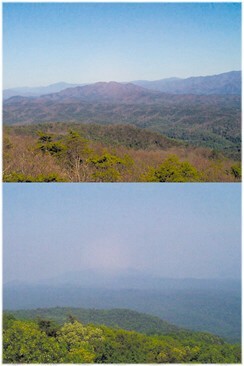 Particles change the atmosphere Particles change the atmosphere
The light and energy of the sun have to pass a lot of barriers on their way through the atmosphere. It is not only the water droplets of the clouds, which blur sometimes the sun. Fine particles also(either liquid or solid) belong to these barriers in the air. We call them aerosols.
Dust and other particles have many natural origins: wind or plant emissions and in very drastic cases volcano eruptions. Large amounts of dust come from industries, car exhaust, power plants, from human induced fires or other changes in the landscape. The anthropogenic contribution to the particle load in the air is remarkable.
|
 |
 |
 |
|
1. The impact of particles on the properties of our atmosphere becomes very obvious to us if they reduce the visibility of the air like on this photo in the Smoky Mountains. (visibility above: about 100 miles, below: about 20 miles)
© Oak Ridge National Laboratory
|
|







